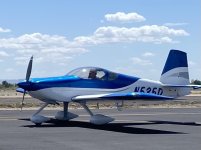I finally finished my RV7-A after 2 years and was surprised by the W&B results. Anyone else find this to be the case? RV7-A, painted, freshly O/H IO360-A1B6 angle valve, 74 inch Hartzell C/S prop, full Oregon Aero interior, All Dynon HDX and A/P, etc and a size "D" Oxy bottle behind the pax seat, PC680 battery behind the pilot seat.
I knew it would be heavy, and it is a bit porky at 1203 lbs because of the engine and prop. (Angle valve A1B6 has the counterweighted crank and weighs about 33 lbs heavier than the parallel valve engine). I was worrying that it would be too nose heavy, concerned about the original style nose gear being overloaded, and that the CG would be too far forward. I was completely wrong! No matter how I load it, I never get a cg that is forward of 55% of allowed, (about 83 inches aft of datum). Of course it moves further aft with fuel burn or with baggage in the back.
However, this one is very fast with the big engine, 10:1 pistons, flowed, polished and ported heads! I also can't get it aft of the limit even with my 205 lb butt, 10 gallons of fuel and 100 lbs of luggage.
Does anyone have a 7A that has a naturally occurring forward CG?

I knew it would be heavy, and it is a bit porky at 1203 lbs because of the engine and prop. (Angle valve A1B6 has the counterweighted crank and weighs about 33 lbs heavier than the parallel valve engine). I was worrying that it would be too nose heavy, concerned about the original style nose gear being overloaded, and that the CG would be too far forward. I was completely wrong! No matter how I load it, I never get a cg that is forward of 55% of allowed, (about 83 inches aft of datum). Of course it moves further aft with fuel burn or with baggage in the back.
However, this one is very fast with the big engine, 10:1 pistons, flowed, polished and ported heads! I also can't get it aft of the limit even with my 205 lb butt, 10 gallons of fuel and 100 lbs of luggage.
Does anyone have a 7A that has a naturally occurring forward CG?





